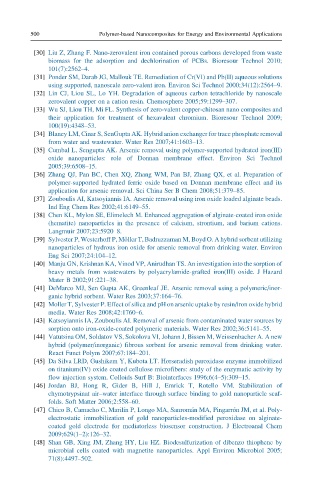Page 547 - Polymer-based Nanocomposites for Energy and Environmental Applications
P. 547
500 Polymer-based Nanocomposites for Energy and Environmental Applications
[30] Liu Z, Zhang F. Nano-zerovalent iron contained porous carbons developed from waste
biomass for the adsorption and dechlorination of PCBs. Bioresour Technol 2010;
101(7):2562–4.
[31] Ponder SM, Darab JG, Mallouk TE. Remediation of Cr(VI) and Pb(II) aqueous solutions
using supported, nanoscale zero-valent iron. Environ Sci Technol 2000;34(12):2564–9.
[32] Lin CJ, Liou SL, Lo YH. Degradation of aqueous carbon tetrachloride by nanoscale
zerovalent copper on a cation resin. Chemosphere 2005;59:1299–307.
[33] Wu SJ, Liou TH, Mi FL. Synthesis of zero-valent copper-chitosan nano composites and
their application for treatment of hexavalent chromium. Bioresour Technol 2009;
100(19):4348–53.
[34] Blaney LM, Cinar S, SenGupta AK. Hybrid anion exchanger for trace phosphate removal
from water and wastewater. Water Res 2007;41:1603–13.
[35] Cumbal L, Sengupta AK. Arsenic removal using polymer-supported hydrated iron(III)
oxide nanoparticles: role of Donnan membrane effect. Environ Sci Technol
2005;39:6508–15.
[36] Zhang QJ, Pan BC, Chen XQ, Zhang WM, Pan BJ, Zhang QX, et al. Preparation of
polymer-supported hydrated ferric oxide based on Donnan membrane effect and its
application for arsenic removal. Sci China Ser B Chem 2008;51:379–85.
[37] Zouboulis AI, Katsoyiannis IA. Arsenic removal using iron oxide loaded alginate beads.
Ind Eng Chem Res 2002;41:6149–55.
[38] Chen KL, Mylon SE, Elimelech M. Enhanced aggregation of alginate-coated iron oxide
(hematite) nanoparticles in the presence of calcium, strontium, and barium cations.
Langmuir 2007;23:5920–8.
[39] Sylvester P, Westerhoff P, M€ oller T, Badruzzaman M, Boyd O. A hybrid sorbent utilizing
nanoparticles of hydrous iron oxide for arsenic removal from drinking water. Environ
Eng Sci 2007;24:104–12.
[40] Manju GN, Krishnan KA, Vinod VP, Anirudhan TS. An investigation into the sorption of
heavy metals from wastewaters by polyacrylamide-grafted iron(III) oxide. J Hazard
Mater B 2002;91:221–38.
[41] DeMarco MJ, Sen Gupta AK, Greenleaf JE. Arsenic removal using a polymeric/inor-
ganic hybrid sorbent. Water Res 2003;37:164–76.
[42] Moller T, Sylvester P. Effect of silica and pH on arsenic uptake by resin/iron oxide hybrid
media. Water Res 2008;42:1760–6.
[43] Katsoyiannis IA, Zouboulis AI. Removal of arsenic from contaminated water sources by
sorption onto iron-oxide-coated polymeric materials. Water Res 2002;36:5141–55.
[44] Vatutsina OM, Soldatov VS, Sokolova VI, Johann J, Bissen M, Weissenbacher A. A new
hybrid (polymer/inorganic) fibrous sorbent for arsenic removal from drinking water.
React Funct Polym 2007;67:184–201.
[45] Da Silva LRD, Gushikem Y, Kubota LT. Horseradish peroxidase enzyme immobilized
on titanium(IV) oxide coated cellulose microfibers: study of the enzymatic activity by
flow injection system. Colloids Surf B: Biointerfaces 1996;6(4–5):309–15.
[46] Jordan BJ, Hong R, Gider B, Hill J, Emrick T, Rotello VM. Stabilization of
chymotrypsinat air–water interface through surface binding to gold nanoparticle scaf-
folds. Soft Matter 2006;2:558–60.
[47] Chico B, Camacho C, Marilı ´n P, Longo MA, Sanroma ´n MA, Pingarro ´n JM, et al. Poly-
electrostatic immobilization of gold nanoparticles-modified peroxidase on alginate-
coated gold electrode for mediatorless biosensor construction. J Electroanal Chem
2009;629(1–2):126–32.
[48] Shan GB, Xing JM, Zhang HY, Liu HZ. Biodesulfurization of dibenzo thiophene by
microbial cells coated with magnetite nanoparticles. Appl Environ Microbiol 2005;
71(8):4497–502.

